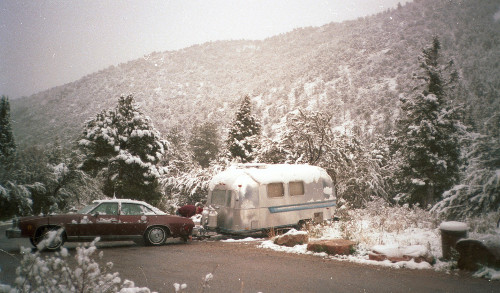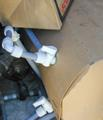
Near Lehman Caves in Eastern Nevada 1991
When the expected low temperatures start to approach freezing in the fall, it is time to take action to minimize the effect of cold temperatures on your RV. Freezing water is not the only concern. The RV batteries also suffer when the weather gets cold. Stores inside may not take well to freezing temperatures. Winter in the Great Basin is also the time for rain and snow which means that leaks and moisture problems need to be addresses.
Caution also needs to be taken in fall and spring to watch out for unexpected storms and cold fronts that may bring in a chill for a day or two. Freezing generally isn't a concern if the low temperatures only dip to the upper twenties for an hour or two but if the daily low temperatures get much below that or stay at freezing or below for several hours or more, freezing can be a real risk.

Near Lehman Caves in Eastern Nevada 1991
See the photo gallery to see pictures of typical drains and valves.
The first thing to do is to make sure you know where all of the drains and valves are on your RV. The valves for the gray and black tanks are often used so they shouldn't be hard to find. The drain and valve for the fresh water tank may be a bit more difficult. The plumbing system may have multiple drains. The hot water heater also has a drain plug. Anything that holds fluid in your RV will have a drain and a valve and you need to locate these and know how to use them.
There may also be bypass valves. Most common are those for hot water heaters. These allow you to use parts of your plumbing system while keeping other parts at lower risk of freezing.
When you are ready to drain all systems, open any faucets to help vent the lines and facilitate drainage. Also disconnect the fresh water tank supply line to the pump (may need modification from original condition).
Drain tanks - black, gray, hot water, fresh water supply, others?
Drain plumbing - hot and cold plumbing lines
Drain accessories - sink sprayer, water filters, shower head line, supply lines, accumulator tanks,
On some trailers, especially the longer ones, there may be plumbing line drains both fore and aft. Manuals for these trailers often suggest using the tongue jack to tilt the trailer one way and then the other after drain valves are opened in order to make sure of good drainage.
There are adapters that allow you to connect an air compressor at your water supply connection in order to use air to help blow out any water in the lines. Caution needs to be taken to make sure the supply air pressure does not exceed nominal water pressures (usually forty or fifty psi). Depending upon air to blow out the plumbing lines may also be rather risky as there may be spots in the plumbing system that remain 'wet' even after blowing air through.
 One
of the big reasons to bypass the hot water tank is that any attempt
to put anti-freeze in the system with the water heater still in line
will need several gallons of fluid to fill the system. With the hot
water heater properly drained and bypassed, less than a gallon of
anti-freeze should be needed to fill the plumbing system.
Accumulators that are installed to reduce pump cycling may also need
removal or bypassing as they hold a gallon or more water.
One
of the big reasons to bypass the hot water tank is that any attempt
to put anti-freeze in the system with the water heater still in line
will need several gallons of fluid to fill the system. With the hot
water heater properly drained and bypassed, less than a gallon of
anti-freeze should be needed to fill the plumbing system.
Accumulators that are installed to reduce pump cycling may also need
removal or bypassing as they hold a gallon or more water.
Be sure to remove any water filters or other special appliances in your plumbing system. These may not only not like freezing but they may also not like anti-freeze. Read manufacturer's manuals to find the best way to winterize them.
 After
any bypasses have been prepared and everything drained close the
plumbing drain valves and faucets. Connect one end of a spare sink
supply line to the water pump and stick the other end into a bottle
of anti-freeze rated for potable water systems and designed for RV
use. Then turn on the water pump. It should quickly get the system up
to pressure and stop. The go to each faucet. Open the faucet: first
hot and then cold, and look for the anti-freeze. When you see the
anti-freeze coming out of the faucet for first cold then hot, close
it and go on to the next one. Don't forget the toilet or the shower
head or the sink sprayer!
After
any bypasses have been prepared and everything drained close the
plumbing drain valves and faucets. Connect one end of a spare sink
supply line to the water pump and stick the other end into a bottle
of anti-freeze rated for potable water systems and designed for RV
use. Then turn on the water pump. It should quickly get the system up
to pressure and stop. The go to each faucet. Open the faucet: first
hot and then cold, and look for the anti-freeze. When you see the
anti-freeze coming out of the faucet for first cold then hot, close
it and go on to the next one. Don't forget the toilet or the shower
head or the sink sprayer!
The antifreeze that comes out of the faucet should be enough to fill the drain traps and keep them from freezing but an extra dollop or two in the drain might be a good idea.
The plumbing systems may be at the most immediate risk due to winter weather but other systems may also suffer if the rig is not exercised on a regular basis.
Heaters – Additional heat can help maintain a minimal temperature in the rig
Batteries need to be connected to a charger/maintainer that will keep them charged and equalized when stored for anything more than a couple of weeks. Also be sure to remove any batteries from clocks, radios, flashlights and other battery powered devices.
Tires should be protected from the sun. Pressures should be checked every month or two to assure they are kept properly inflated.
Rust prevention means a light coating of grease or fresh paint depending upon what is exposed.
Stores should be evaluated for their survival at temperature extremes over time. Remove anything from the rig that might freeze or rot or otherwise suffer from temperature extremes.
Infestation, especially by mice, may need attention.
Gaskets, seals, and other rubber parts should be coated with a lubricant and protectant.
Moisture from leaks or condensation can cause staining or rot. Inspect the rig every now and then, especially after wet storms, to see if anything needs fixing.
Ventilation should not be ignored. Find a way to prop the door of the refrigerator open a bit. See if you can crack a window or vent to allow air to move throughout the rig without undue risk of snow or rain blowing in.
Shut off propane tank valves and provide some cover for the tanks and the regulator. Any other outside valves or devices should also be protected from the weather.
Check through the links in the resources for additional ideas and checklists that you may find useful.
See the photo gallery for Winterizing
Texas Trader checklist for storing your trailer -
Outdoorsite with some good tips, too - http://www.outdoorsite.com/site/go.cfm/owner/FF9FE5D7-6FD5-463D-A13733C2C1D6E4D1
RV-Times - good stuff on accessories - http://www.rvtimes.com/columns.php?file=rvrepairs&article=91
Cliff Maurand - plumbing, tires and other things - http://www.gonecamping.net/stories/winterize.html
Prestone's RV antifreeze product - http://www.prestone.com/framer.cgi?page=http://www.prestone.com/products/16.htm
RVIA - http://www.rvia.org/consumers/recreationvehicles/takingcare/Winterizing.htm
The Storage Bin - http://www.storagebin.ab.ca/winterize.htm - Engine & Chassis Systems, Fuel & Lubrication , Freshwater & Sanitation Systems, Interiors & Exteriors
Les Doll Rvers Corner - http://www.rverscorner.com/articles/painless.html - he has step by step with pictures.
RV Net Links - http://www.rvnetlinx.com/htlist05.php3 -
De-winterizing as originally printed in Escapee's - http://bart.ccis.com/home/mnemeth/skp/dewinterize.htm -
Sierra Nevada Airstreams: Destinations - Owners - Community - Family - Memories - Education - WBCCI Unit - Quicksand - Commerce
|
copyright
2019 Leipper
Management Group. All rights reserved
Please
address comments or questions to webmaster@leipper.org
Last updated
|
Sierra Nevada Airstreams - photograph policy - supporting and using open software |
note: all photographs on this site are for personal, private, and non-commercial use only. All other copyrights are retained by the individual photographers. See our policy. Disclaimer: any advice or suggestion presented is provided for informational purposes only and is correct and accurate only to the best of our knowledge at the time it was written. Anyone using such information does so at their own risk. Errors or omissions may exist and additional sources of information or appropriately licensed or qualified personnel should be consulted in deciding a course of action. We assume no liability or obligation by providing this information and warn any users of this information that they do so at their own risk. All links or references to commercial vendors or other sources of information and equipment do not intend or imply or convey any endorsement of that source or the product. They are provided strictly for informational purposes to illustrate the topic at hand. Sierra Nevada Airstreams Enjoyment of the whispering winds, the zephyrs, the airstreams of the Sierra Nevada and Great Basin areas of the United States is a personal, nonprofit, noncommercial web site intended for educational and recreational use only. This site is supported by volunteer effort and contributions. Donations accepted thanks to the Amazon.com